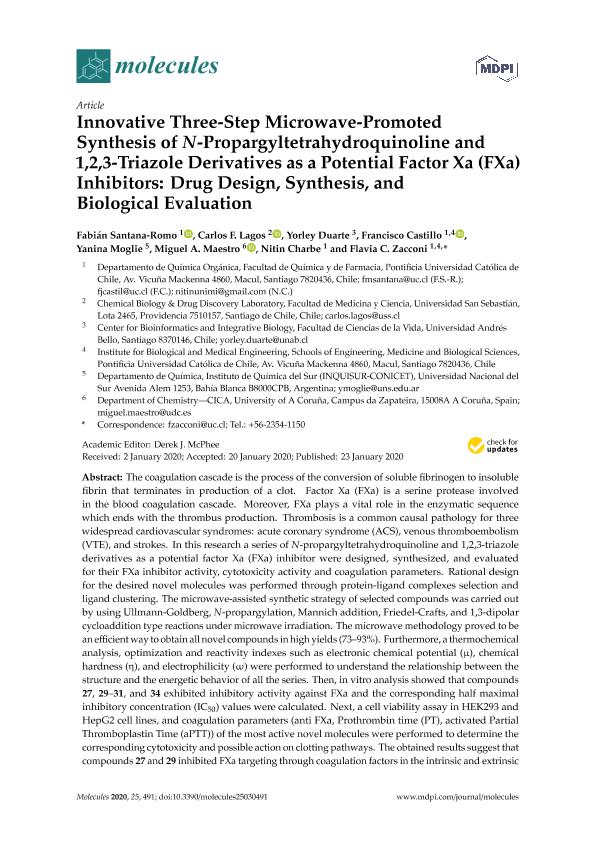Mostrar el registro sencillo del ítem
dc.contributor.author
Santana Romo, Fabián

dc.contributor.author
Lagos, Carlos F.

dc.contributor.author
Duarte, Yorley
dc.contributor.author
Castillo, Francisco

dc.contributor.author
Moglie, Yanina Fernanda

dc.contributor.author
Maestro, Miguel A.

dc.contributor.author
Charbe, Nitin
dc.contributor.author
Zacconi, Flavia Cristina Milagro

dc.date.available
2021-01-27T02:55:04Z
dc.date.issued
2020-01-23
dc.identifier.citation
Santana Romo, Fabián; Lagos, Carlos F.; Duarte, Yorley; Castillo, Francisco; Moglie, Yanina Fernanda; et al.; Innovative Three-Step Microwave-Promoted Synthesis of N-Propargyltetrahydroquinoline and 1,2,3-Triazole Derivatives as a Potential Factor Xa (FXa) Inhibitors: Drug Design, Synthesis, and Biological Evaluation; Molecular Diversity Preservation International; Molecules; 25; 3; 23-1-2020; 1-39
dc.identifier.issn
1420-3049
dc.identifier.uri
http://hdl.handle.net/11336/123829
dc.description.abstract
The coagulation cascade is the process of the conversion of soluble fibrinogen to insoluble fibrin that terminates in production of a clot. Factor Xa (FXa) is a serine protease involved in the blood coagulation cascade. Moreover, FXa plays a vital role in the enzymatic sequence which ends with the thrombus production. Thrombosis is a common causal pathology for three widespread cardiovascular syndromes: acute coronary syndrome (ACS), venous thromboembolism (VTE), and strokes. In this research a series of N-propargyltetrahydroquinoline and 1,2,3-triazole derivatives as a potential factor Xa (FXa) inhibitor were designed, synthesized, and evaluated for their FXa inhibitor activity, cytotoxicity activity and coagulation parameters. Rational design for the desired novel molecules was performed through protein-ligand complexes selection and ligand clustering. The microwave-assisted synthetic strategy of selected compounds was carried out by using Ullmann-Goldberg, N-propargylation, Mannich addition, Friedel-Crafts, and 1,3-dipolar cycloaddition type reactions under microwave irradiation. The microwave methodology proved to be an efficient way to obtain all novel compounds in high yields (73–93%). Furthermore, a thermochemical analysis, optimization and reactivity indexes such as electronic chemical potential (μ), chemical hardness (η), and electrophilicity (ω) were performed to understand the relationship between the structure and the energetic behavior of all the series. Then, in vitro analysis showed that compounds 27, 29–31, and 34 exhibited inhibitory activity against FXa and the corresponding half maximal inhibitory concentration (IC50) values were calculated. Next, a cell viability assay in HEK293 and HepG2 cell lines, and coagulation parameters (anti FXa, Prothrombin time (PT), activated Partial Thromboplastin Time (aPTT)) of the most active novel molecules were performed to determine the corresponding cytotoxicity and possible action on clotting pathways. The obtained results suggest that compounds 27 and 29 inhibited FXa targeting through coagulation factors in the intrinsic and extrinsic pathways. However, compound 34 may target coagulation FXa mainly by the extrinsic and common pathway. Interestingly, the most active compounds in relation to the inhibition activity against FXa and coagulation parameters did not show toxicity at the performed coagulation assay concentrations. Finally, docking studies confirmed the preferential binding mode of N-propargyltetrahydroquinoline and 1,2,3-triazole derivatives inside the active site of FXa.
dc.format
application/pdf
dc.language.iso
eng
dc.publisher
Molecular Diversity Preservation International

dc.rights
info:eu-repo/semantics/openAccess
dc.rights.uri
https://creativecommons.org/licenses/by-nc-sa/2.5/ar/
dc.subject
1,2,3-TRIAZOLE
dc.subject
CELL VIABILITY ASSAY
dc.subject
COAGULATION PARAMETERS
dc.subject
FACTOR XA INHIBITORS
dc.subject
MICROWAVE-ASSISTED SYNTHESIS
dc.subject
N-PROPARGYLTETRAHYDROQUINOLINE
dc.subject.classification
Química Orgánica

dc.subject.classification
Ciencias Químicas

dc.subject.classification
CIENCIAS NATURALES Y EXACTAS

dc.title
Innovative Three-Step Microwave-Promoted Synthesis of N-Propargyltetrahydroquinoline and 1,2,3-Triazole Derivatives as a Potential Factor Xa (FXa) Inhibitors: Drug Design, Synthesis, and Biological Evaluation
dc.type
info:eu-repo/semantics/article
dc.type
info:ar-repo/semantics/artículo
dc.type
info:eu-repo/semantics/publishedVersion
dc.date.updated
2020-05-19T18:30:13Z
dc.journal.volume
25
dc.journal.number
3
dc.journal.pagination
1-39
dc.journal.pais
Suiza

dc.journal.ciudad
Basel
dc.description.fil
Fil: Santana Romo, Fabián. Pontificia Universidad Católica de Chile; Chile
dc.description.fil
Fil: Lagos, Carlos F.. Universidad San Sebastián; Chile
dc.description.fil
Fil: Duarte, Yorley. Universidad Andrés Bello; Chile
dc.description.fil
Fil: Castillo, Francisco. Pontificia Universidad Católica de Chile; Chile
dc.description.fil
Fil: Moglie, Yanina Fernanda. Consejo Nacional de Investigaciones Científicas y Técnicas. Centro Científico Tecnológico Conicet - Bahía Blanca. Instituto de Química del Sur. Universidad Nacional del Sur. Departamento de Química. Instituto de Química del Sur; Argentina
dc.description.fil
Fil: Maestro, Miguel A.. University of A Coruña; España
dc.description.fil
Fil: Charbe, Nitin. Pontificia Universidad Católica de Chile; Chile
dc.description.fil
Fil: Zacconi, Flavia Cristina Milagro. Pontificia Universidad Católica de Chile; Chile
dc.journal.title
Molecules

dc.relation.alternativeid
info:eu-repo/semantics/altIdentifier/url/https://www.mdpi.com/1420-3049/25/3/491
dc.relation.alternativeid
info:eu-repo/semantics/altIdentifier/doi/http://dx.doi.org/10.3390/molecules25030491
Archivos asociados
